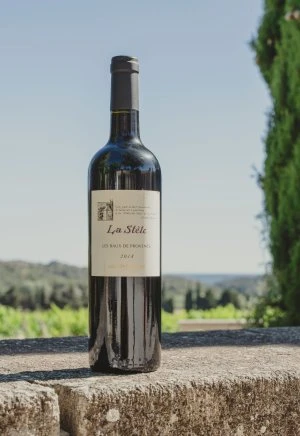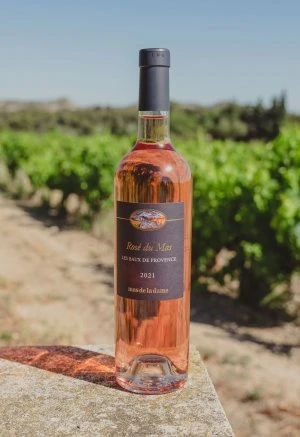
Mas de la Dame
The same local families have been helping us
with the grape picking for generations.
Anne Poniatowski is proud of this unique joint venture, both as the owner of the estate (along with her sister) and as the first citizen of Les Baux-de-Provence.

Far from the glittering coast and glamorous lights of the Côte d'Azur, Provence is a kaleidoscope of red tiled roofs, pastel-coloured facades, centuries-old farms and castles, sleepy squares, fields and vineyards dotted with flowers.
Its spirit of place comes across to me in the cries of children chasing a ball, in the blade of a knife plunging into a fig tree and in the excited chirping of the cicadas.
At the end of the long, winding road surrounding the fortress of Les Baux-de-Provence, Mas de la Dame appears with its pale stone buildings and powder blue shutters.
Before driving down the long driveway, I stop the car at the very same spot where Vincent Van Gogh set up his easel in 1889 to immortalise the façade of the estate and give life to the work: "Landscape in the Neighbourhood of Saint-Rémy". I still don’t know that I’m going to hear the story of his stay here in Provence and its harrowing epilogue.


With its row of small windows peering out over the white gravel courtyard, for me Mas de la Dame sums up the very essence of Provence. Men and animals move torpidly, or not at all; standing in the shade of the plants to find some relief from the heat. It is midsummer here in the south of France. The breeze is hot and dry, it feels like having a hairdryer held up in front of your face.
Under a blazing sun, Anne Poniatowski comes out to welcomes us, immediately inviting us in. An elegant and pragmatic woman, with a no nonsense air, we realise this is someone with much to do and for whom time, understandably, is something of a luxury.
Together with her sister Caroline Missoffe, not only is Anne the owner of the Domaine, but she is also the mayor of Les Baux-de-Provence.
In 1903, Auguste Faye, a merchant from Burgundy and great-grandfather of the two sisters, fell in love with the small estate of Mas de la Dame and bought it. He left it to his son Robert (Anne and Caroline's grandfather), who became convinced of the potential of this terroir. He decided to plant it out, alternating between vine and olive groves, just as the ancient Romans did when they settled in the region several centuries earlier. Thus, was born the first winery in the Vallée des Baux, which today boasts 57 hectares of vines and 28 hectares of olive trees.
"Our grandfather was the first producer in the entire valley," Anne explains, "and now the designation Les Baux-de-Provence comprises only 11 estates, where grapes are harvested from eight communes in the Alpilles hills."
However, the story of Mas de la Dame, literally “The Lady's Farm”, begins long before 1903. According to legend, a woman in despair at the loss of her beloved knight, took a vow of solitude and chastity and retired to live in a farm near Les Baux de Provence. It is from her that the estate is said to have received its mysterious name. The somewhat less fictional version has it that the Lady of the Farm was Hélène Hugolène, the Lady of Fos, owner of the Domaine in the 15th century.
The whole time Anne is speaking, I remain silent: I feel like I am in a history lesson.
Mas de la Dame is in one of the prophecies of Nostradamus,
who was born right here in Saint-Rémy-de-Provence and referred to this very place in one of his quatrains about the end of the world: "The sea will cover the earth and stop at the stele of Mas de la Dame." My eye is irresistibly drawn to the stele outside the window.
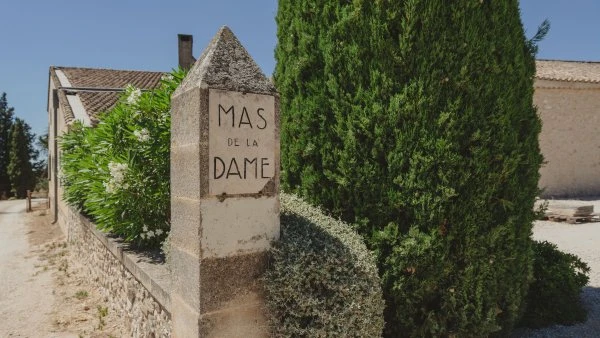
Mas de la Dame is in a painting by Vincent Van Gogh.
Indeed, it was here in Saint-Rémy-de-Provence that the artist found mental relief for 53 days, checking into the psychiatric hospital as if he were a hotel guest. Then, shortly after being discharged, he took his own life, but not before he had depicted the estate in his art, thus consigning it to humanity and eternity.
Mas de la Dame is in the pen of Simone de Beauvoir,
who mentions the estate in La Force de l'âge: “The wind was blowing over Les Baux when I arrived there... A fire crackled in the Camino de la Reine Jeanne where we were the only guests. We dined at a small table near the hearth, drinking a wine whose name I still remember, the Mas de la Dame."
The tale is so intriguing I didn't even notice that two bottles had appeared: La Stèle Blanc and Rosé du Mas. They are the first two examples of natural wine we taste.

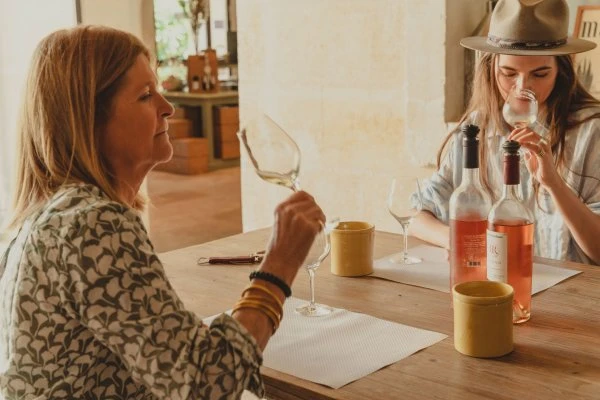

Their grapes, like those of all the wines produced by Mas de la Dame, are cultivated and vinified using solely natural processes, and without the use of chemicals, which means that the wines they produce are alive, rich in natural microbiology, and have every right to be certified Agriculture Biologique.
Anne tells us that, “natural wines are more fun because they are more unpredictable. We don't aim to make a standard product year after year; rather, we aim for a constant collaboration with nature, thereby enabling us to make the best products."


Subscribe
Every month we will present an unknown and exclusive winery we have discovered. Every month you will receive what we consider to be its best bottle delivered directly to your door: a wine that is always new, exclusive and surprising. At Christmas, 10% discount.
Simona and I are impressed by Anne's energy. In 1994, she and her sister took over the running of the estate from their parents. Citizens of the capital with full and fulfilling lives, they decided to leave Paris and their respective professions - economics and finance journalist Anne, fashion journalist Caroline - to take over the reins of the Domaine. A radical change of life.
Today, not only do they proudly represent the 4th generation of the family estate, they are also strongly rooted in the community. Whilst Anne, as we already know, is the first citizen of Les Baux-de-Provence, Caroline is the president of the Les Baux-de-Provence appellation.
Meanwhile, as if by magic, four more bottles have appeared: La Stèle Rouge, Réserve du Mas, Coin Caché Blanc and Coin Caché Rouge. With its strong-willed personality, it is the latter that catches my attention in particular. Of a red that can be no redder, to some it brings to mind strawberry soup, whilst others compare it to a cherry and plum brandy. Sinking my nose into its bouquet, I am struck by its aromatic personality. When I draw it over my palate, it is an explosive red-fruit salad. This wine has a style all of its own, stubborn and impudent, so much so that I seem to hear it say "I am the red I want to be and I define my own rules of excellence."

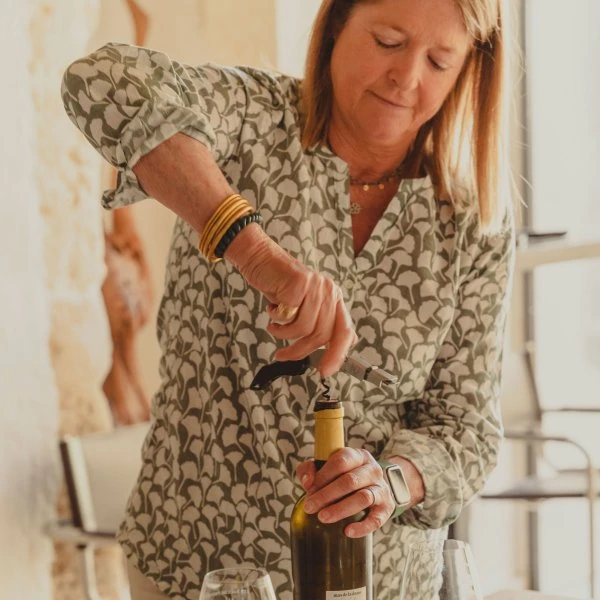

La Stèle Blanc, Rosé du Mas, La Stèle Rouge, Réserve du Mas, Coin Caché Blanc and Coin Caché Rouge are the natural wines of Mas de la Dame you absolutely have to try.
At this point in time, I find the all too common assumption that natural winemaking requires less skill, simply because it is bound by fewer rules, even more mistaken. Indeed, the very lack of structure is compensated by even more knowledge and more intuition.
Anne adds a curious piece of information to her tale. “Every year, during the harvest, there are whole local families who come to give us a hand. Literally, since the harvest is entirely manual. The wonderful thing is that it's always been the same families, for generations. They formed a bond with Mas de la Dame long ago and have never loosened it since."
A singular joint venture indeed, and evidently one of which both the owner and first citizen are proud.

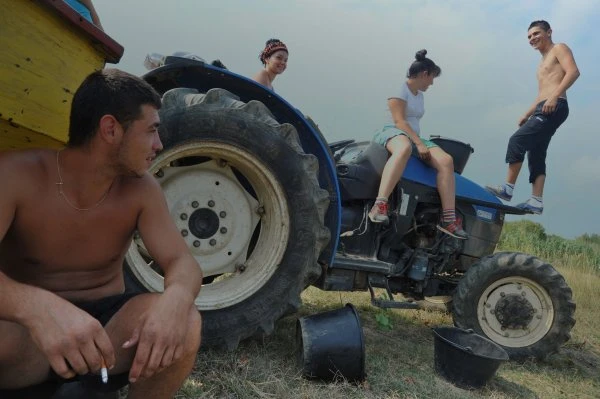
Thanks to Simona's winning smile, we manage to convince our overburdened hostess to let us steal a few minutes more and take us to her wines’ resting place. These are the old concrete vats built by her grandfather Robert and now given a new lease of life. The wine once matured in these vats has stained them an intense, almost abyss-like red. The patina of a once-living material covers the walls, crumbling to the touch. Neat rows of barrels face us, concealing their contents.



The air we breathe is fresh, inviting us to remain forever. For a wine lover like me, it is like the sirens’ song to Ulysses.

The mayoress has to take her leave: we’ve kept her too long from her duties.
As we get back in the car, Simona tells me she doesn't want to go home; she wants to explore. Great news! I love driving aimlessly, and even more so on dirt tracks, so I head off up a long, steep track winding its way up into the mountains. I feel like I’m driving in Sardinia. The road climbs and opens out into a clearing. The landscape is deserted, almost prehistoric. We are on the edge of a precipice: 40 metres below us is a lagoon, born inside an old, abandoned quarry. With Alpine-lake hues, it invites you to plunge into its refreshing depths.
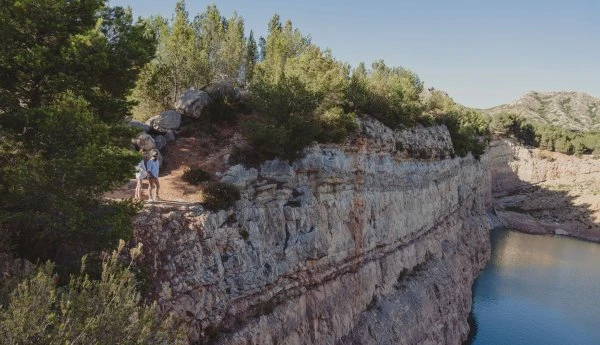
In the meantime, a family has scrambled down into the lagoon, gaining access where lorries once entered the quarry. Seated on the edge of the deep void, Simona and I feel like two extras in a Luca Guadagnino film as we watch them frolicking in the water.











